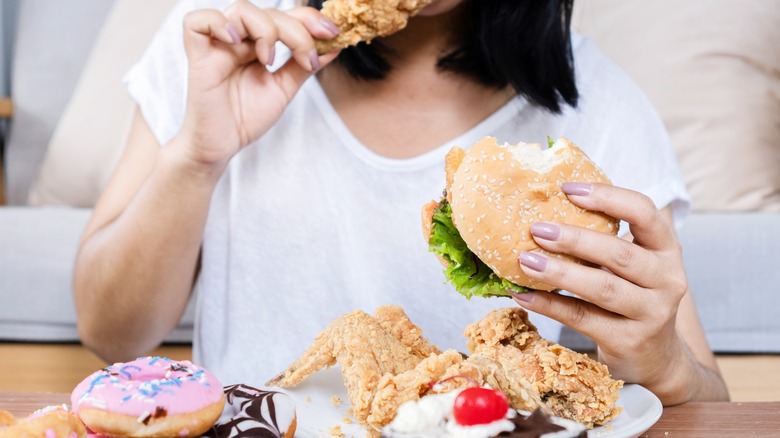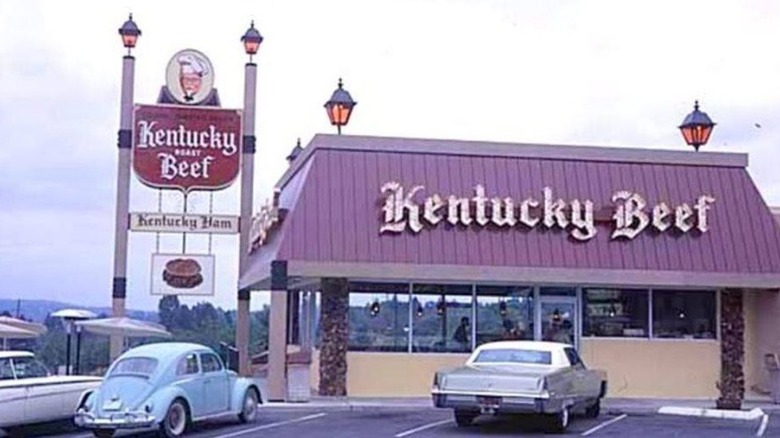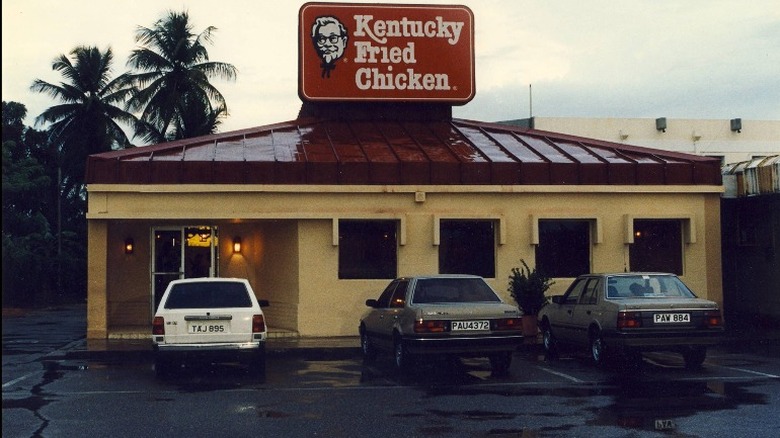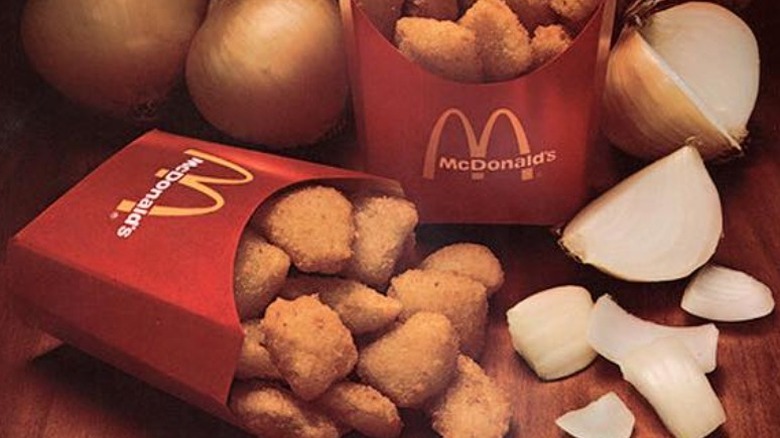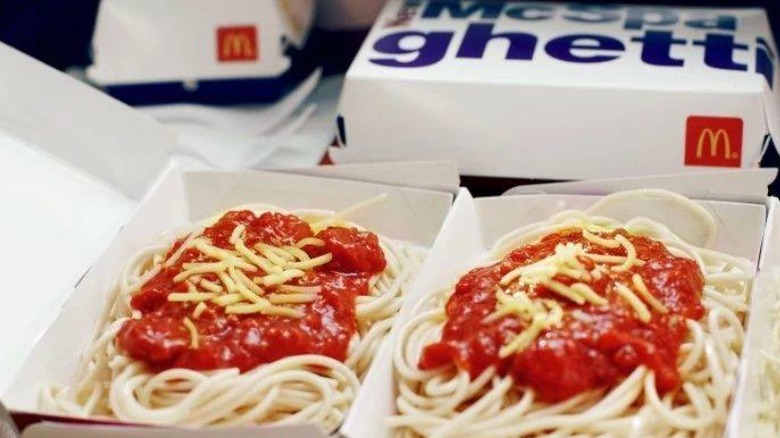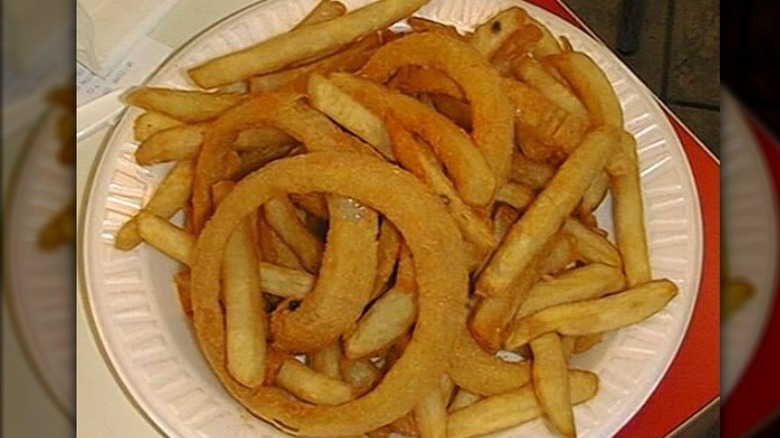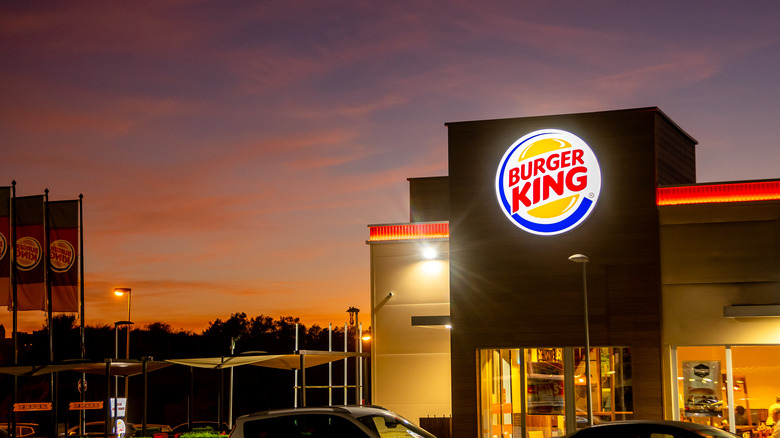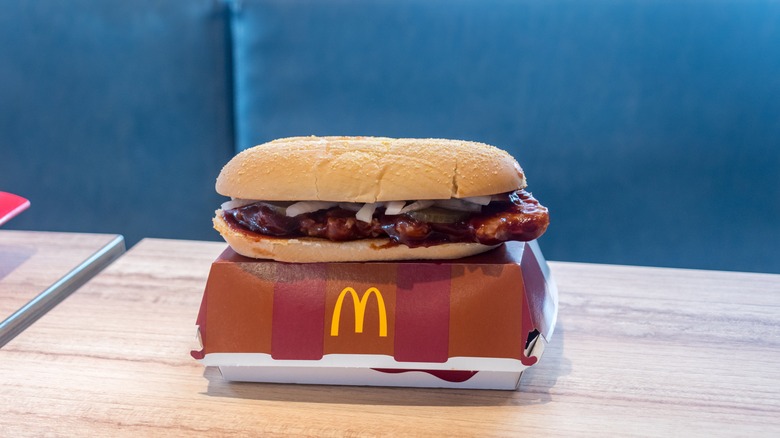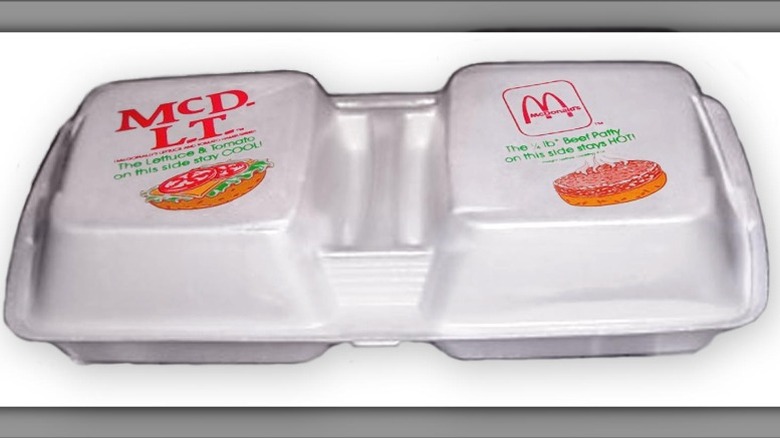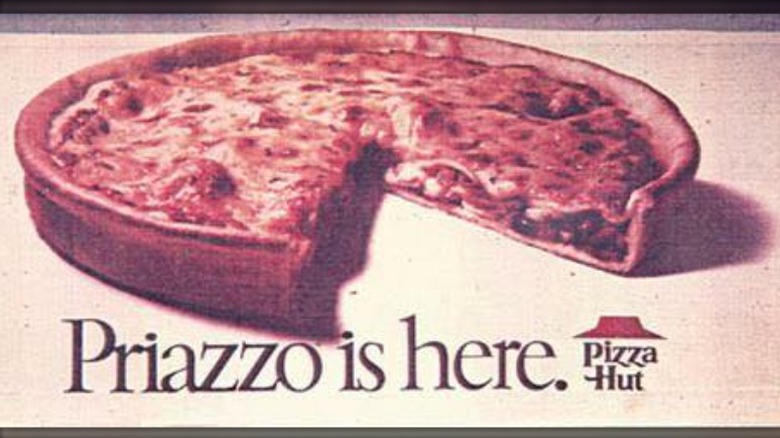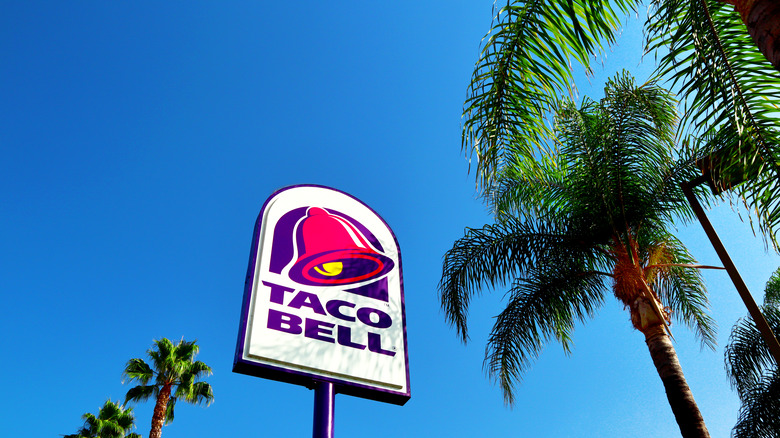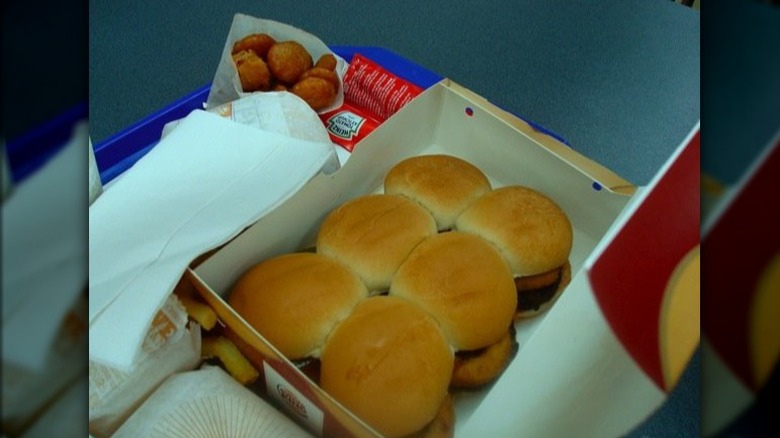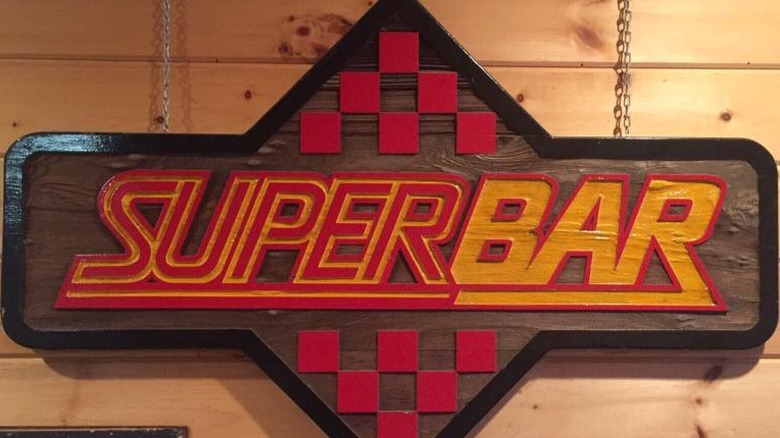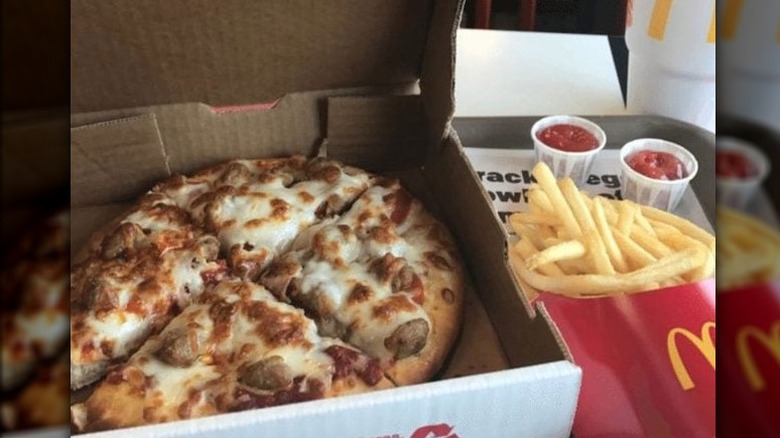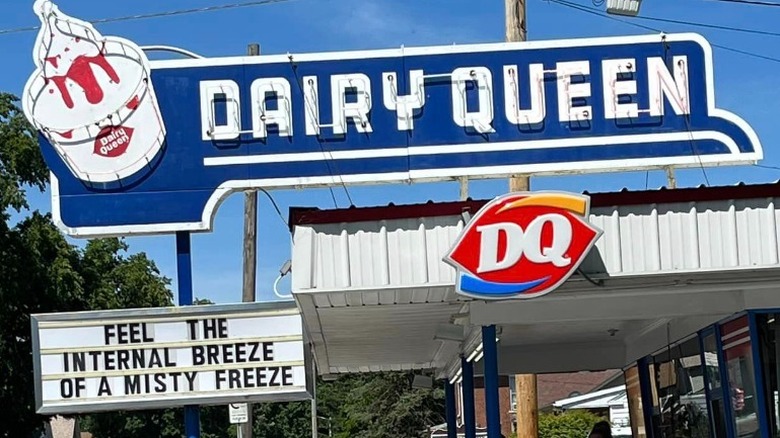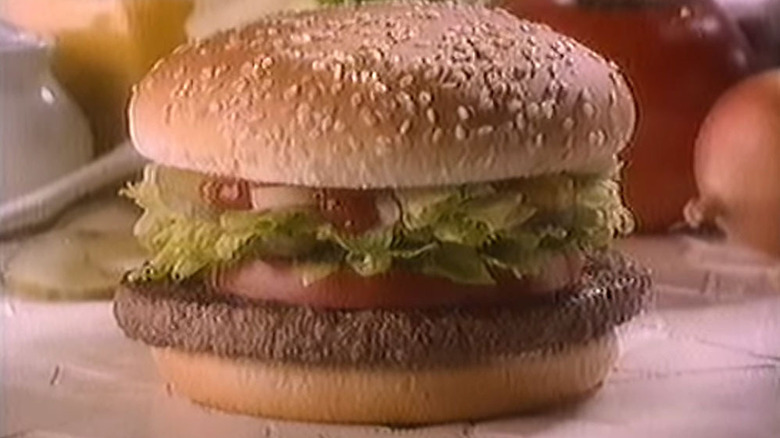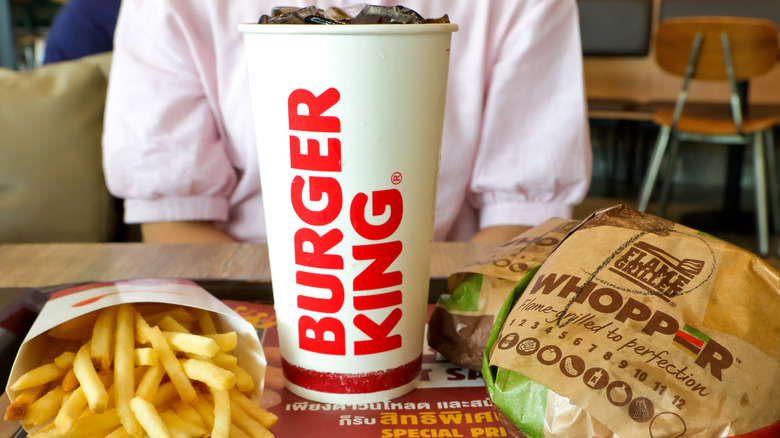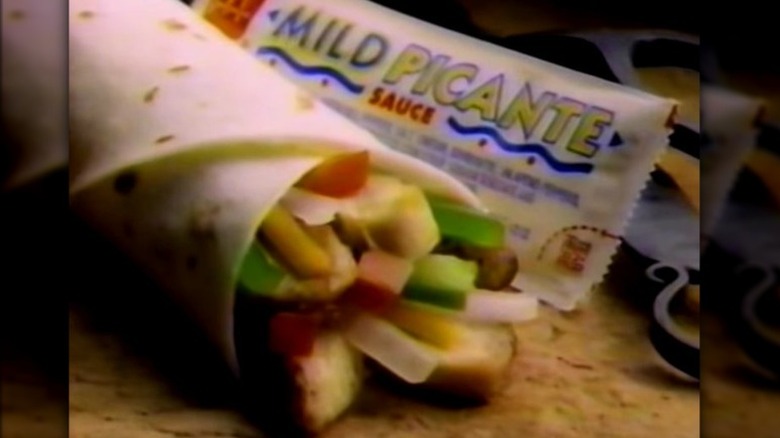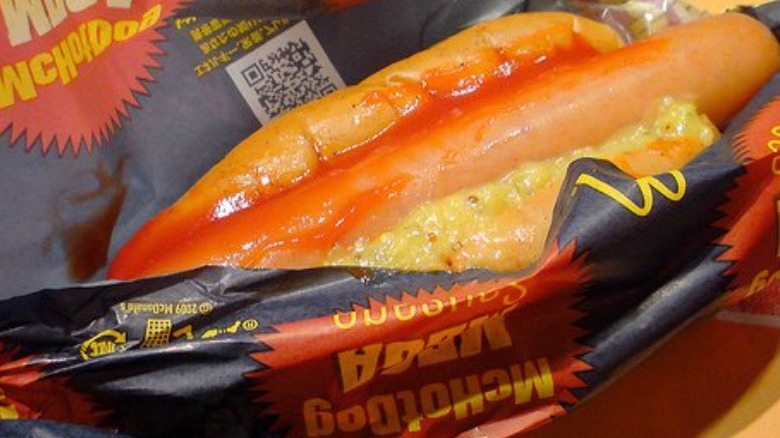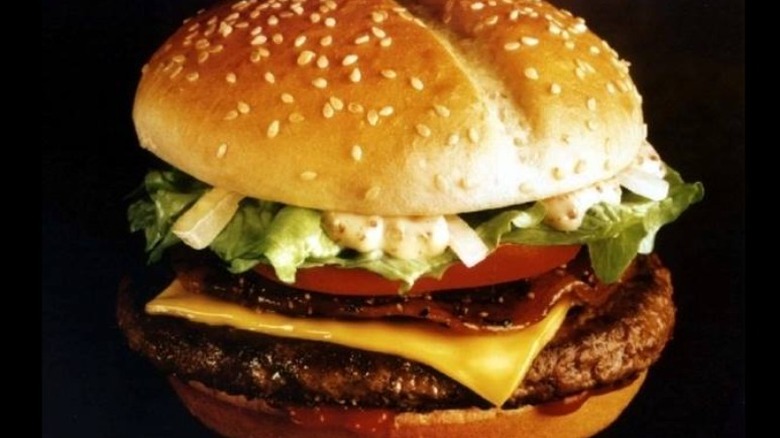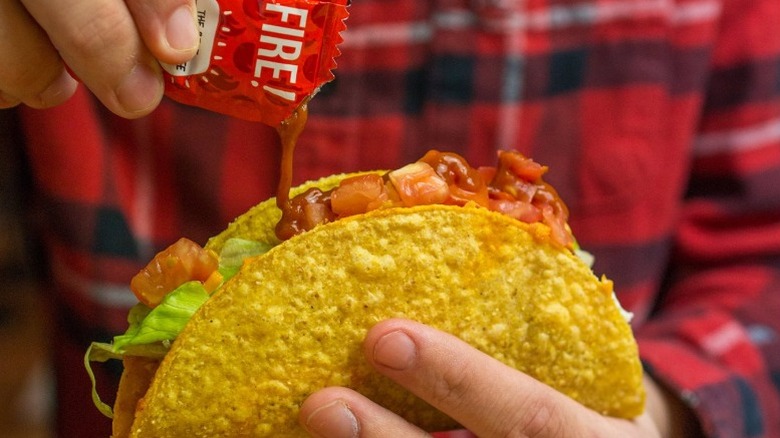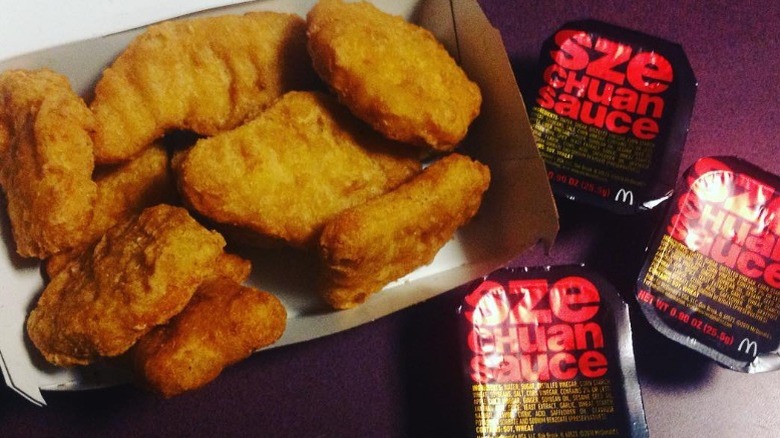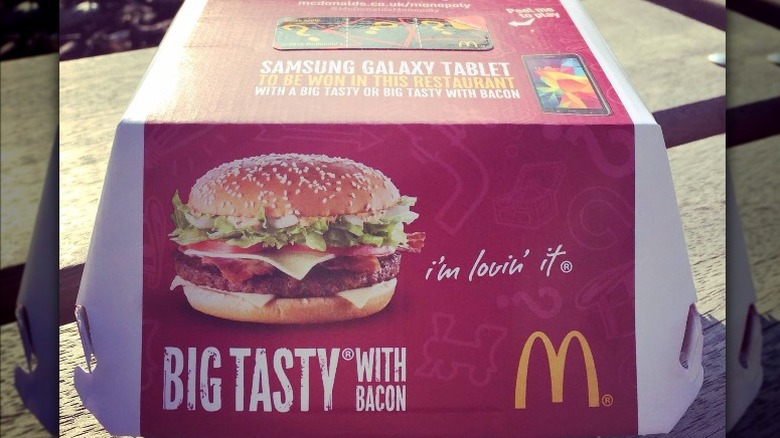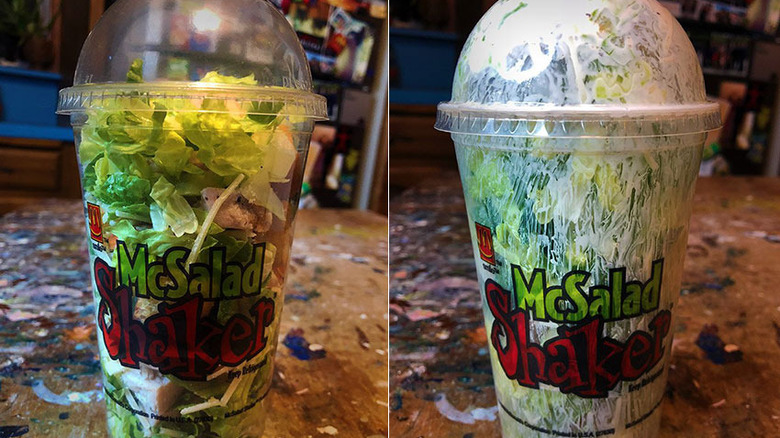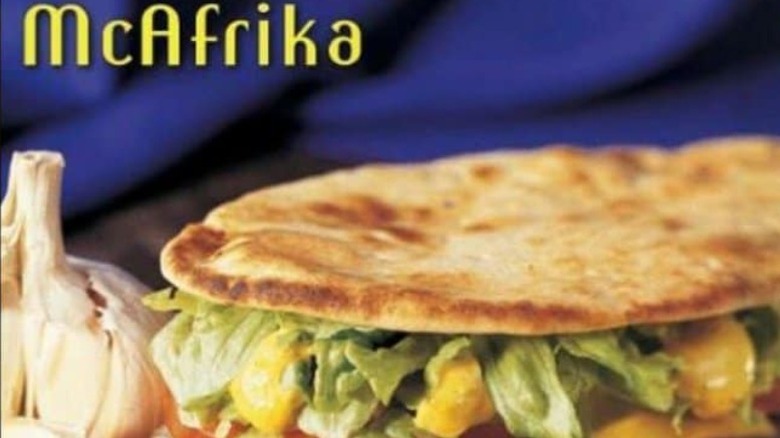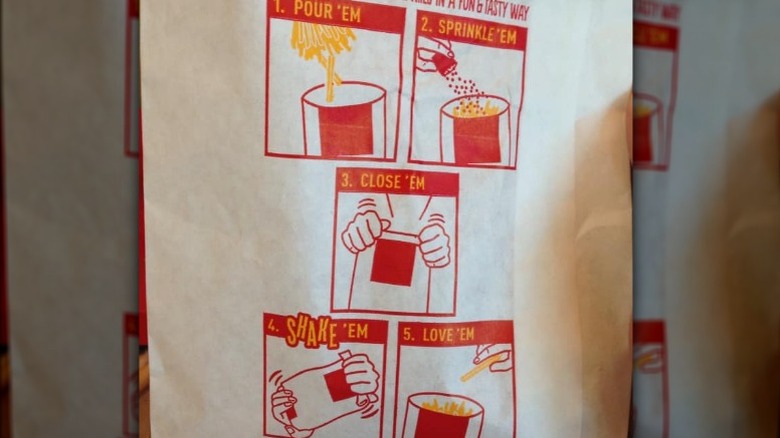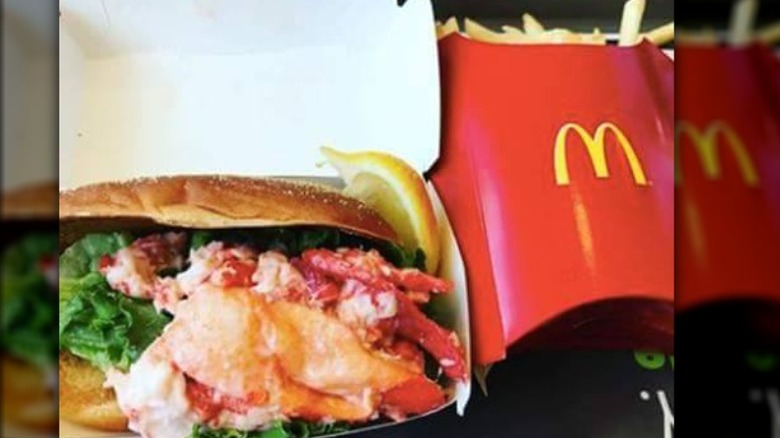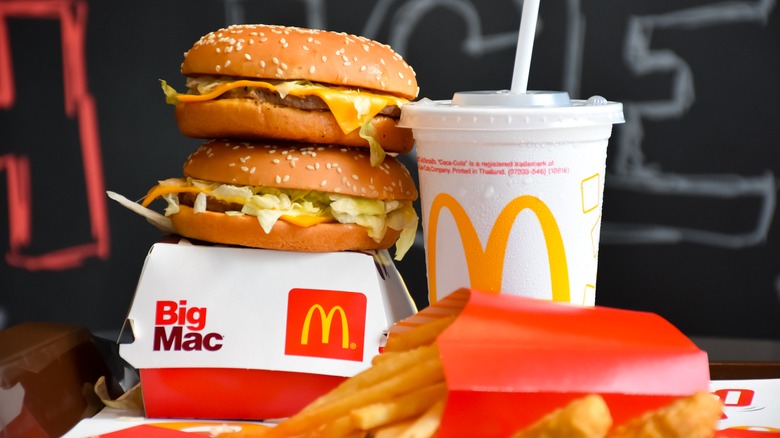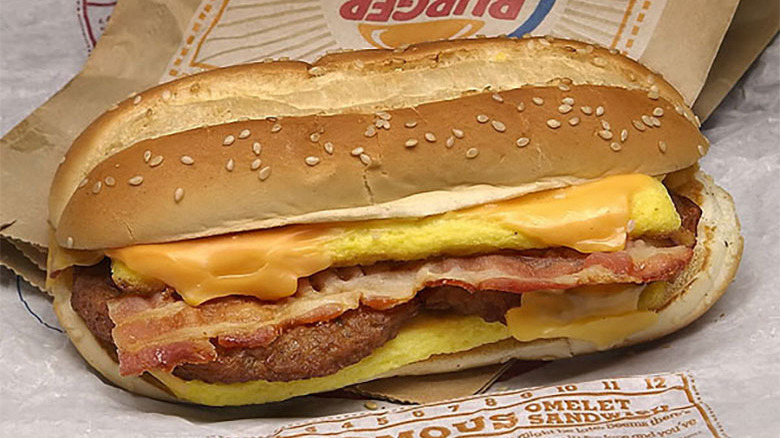The Biggest Fast Food Flops From The Year You Were Born
Chowing down on fast food is one of America's most cherished national pastimes. According to NBC News, 80% of Americans indulge in fast food weekly. Honestly, how could we not? Fast food hits the taste trifecta perfectly with equal parts salty, fatty, and cheesy, and that's just the savory items. Sink your spoon into one of Dairy Queen's Blizzards, and you'll enjoy an explosion of creamy soft serve flecked with candy and swirls of caramel or chocolate.
Although there are many fast food items you need to eat before you die, not every fast food delicacy can be an original Popeye's chicken sammie or a fully-loaded Wendy's Baconator. Unfortunately, some fast food flops will live on in infamy as the times our fast food titans of taste really stepped in it, either through tone-deaf promotions, menu over-reaches, or downright bizarre diversions from the fast food we know and love. Let's dig into some of the biggest flops in fast food history.
1968-1970: Kentucky Roast Beef
Coming in hot on the success of its fried chicken chains, KFC tried a different tactic at the end of the 1960s that blew up in flames at the dawn of the 1970s. According to The Vintage News, the ill-fated Kentucky Roast Beef sold both ham and beef and was optimistically successful in a few test markets in the American Southwest. But, in a move that hinted at muddled branding, some KFC beef joints were called "Kentucky Roast Beef 'n' Ham" while others dropped the ham for "Kentucky Roast Beef."
In the end, Kentucky Roast Beef/Ham failed to turn a profit thanks to high overhead and a not-so-great bargain compared to the fried chicken offerings. Some restaurants eventually returned to being good old-fashioned KFCs.
1971-1977: KFC's Ribs
Kentucky Roast Beef wasn't KFC's only memorable misstep. In the 1970s, the chain launched a line of ribs, that some lauded as being the sticky, saucy, meaty stuff of childhood nostalgia (via In the 70s) while others found them to be downright nasty. According to LTH Forum, these "ribs" bore little resemblance to their hearty BBQ joint counterparts, instead being "meat-like paste" slathered on some bones that even dogs wouldn't touch.
Although these ribs are long gone, KFC is trying its hand with a new variation in South Korea; chicken-based, not meat paste this time (via Brand Eating).
1978: McDonald's Onion Nuggets
The idea of McDonald's Onion Nuggets might elicit a visceral squirm, but the fried onion bits did exist outside your wildest nightmares for a brief period in the late 1970s. According to Mental Floss, these deep-fried onion cubes were the original frontrunners to the McFavorite McDonald's Chicken McNuggets, which hit the market in 1980. According to The Grist, Onion Nuggets might be a larger, chunkier riff on onion rings, but unlike the nearly universally popular rings, these only hit four test markets before vanishing.
However they emerged, and why, it's clear that Onion Nuggets were an epic flop. Even today, Reddit users pan them as "just wrong."
1979-1980 McSpaghetti
According to Christian Science Monitor, McSpaghetti emerged in the late 1970s as part of McDonald's bid to break into the casual, middle-of-the-road dinner biz. McSpaghetti, fettuccine Alfredo, and lasagna all graced the McMenu, but none stuck, at least not in the United States. McSpaghetti might have failed because it's too sweet for American tastes, but this long-gone Mcdonald's entree has a new life in the Philippines, where you can pick up your McSpaghetti with a side of fries or nuggets (via AZ Central).
Noting it as a "sweet foray into Filipino flavors," ABS-CBN notes that the sauce that landed as too saccharine on this side of the pond was embraced for its meaty, sweet deliciousness in Southeast Asia.
1981: Jack in the Box Frings
Jack in the Box's inspired combo of two fried favorites, onion rings, and fries, was a short-lived phenomenon that's still legendary on Reddit. Anyone who's ever gotten a stray onion ring in their French fries can certainly relate to why Jack in the Box thought a mixture of the two would be a great idea. According to Jack in the Box Fandom Frings burst onto the scene in 1979 and fizzled out right at the beginning of the 1980s, although plenty of people mourn the fried duo.
Love them or hate them; you have to admire Jack in the Box's ingenuity.
1982: Burger King Veal Parmigiana
Although Burger King's veal parmigiana actually launched in 1980, the controversy surrounding this specialty sammie came to a fever pitch in 1982, when Burger King found itself in the crosshairs of PETA and animal rights advocates over its meat choice.
According to Christian Science Monitor, Burger King's veal parmigiana sandwich did pretty well for the first bit of its short-lived fast food run until it ran afoul of outraged animal advocates who called for mass boycotts and resulted in Burger King removing the sandwich from the majority of its franchises. Today, you can't find veal parmigiana at Burger King, and the infamous sandwich is wildly debated on Reddit.
1983: McDonald's McRib
Behold, the sandwich that Reddit calls "glorious and terrible," a fast food flop in its time but a fan favorite years later, the weird, wonderful, and wildly over-processed McRib. According to MassLive, the McRib is a plethora of different flavors, many of them over-the-top, making this sandwich one of the most polarizing offerings that McDonald's had on the menu. Additionally, the McRib is packed with preservatives and highly processed (via HuffPost).
McRib's initial run might have been a flop, but it keeps coming back thanks to McRib devotees (via Restaurant Business). There's even a McRib Locator so that you can find the salty, meat-molded McRib nearest you.
1984: McDonald's McDLT
Another McFlop, the McDonald's D.L.T., was canceled not for taste-related reasons or sheer weirdness but for packaging. According to Reader's Digest, the McDLT was a simplistic but satisfying combination of a burger, lettuce, tomato, pickles, and cheese. Introduced in the mid-1980s, the McDLT's charm came from its hot and cold components, kept separate and temperature controlled in two halves of the Styrofoam container that would be its undoing.
Discontinued in 1991 after six glorious years (via BuzzFeed), the McDLT lives on in McLore as one of the most delicious and innovative sandwiches the chain has ever offered.
1985: Pizza Hut Priazzo
As this vintage 1985 commercial illustrates, The Priazzo was Pizza Hut's spin on deep-dish pizza, an over-stuffed, weighty chunk of pie loosely based on Italian recipes, yet barely authentic by any objective measurements (via Orlando Sentinel). According to the Retroist, the Priazzo was a multi-layered pie with several crusts, plenty of sauce, and tons of cheese and fixin's that Pizza Hut launched right after its Personal Pan Pizza.
Unfortunately for the Priazzo, the devil was in the details, or in the Priazzo's case, the timing it took to get this intricate pizza pie just right. People didn't have the patience to wait the better part of an hour for their pie, and the Priazzo flopped.
1986: Taco Bell Seafood Salad
Taco Bell's mid-80s seafood salad was intended as a way to one-up fast food giants like McDonald's, whose Filet-o-Fish was flying out of franchise drive-thrus, but wound up being a huge flop. As this vintage 1986 ad illustrates, Taco Bell took direct aim at McDonald's but quickly found themselves in unfamiliar seas with a salad that didn't live up to the hype and seemed downright bizarre on a fast food menu.
To make matters worse, Taco Bell's seafood salad was also allegedly linked to some food poisoning cases, ending its short, gross reign as Taco Bell's foray into fish (via Spoon University).
1987: Burger King Burger Bundles
Burger King's 1987 Burger Bundles might have emerged as a clap back to White Castle's success both in the fast food and pop culture arenas. According to Cheapism, The Beastie Boys even featured White Castle sliders in several songs, possibly prompting the king of burgers to make a move. In this rad and retro 1987 commercial, Burger Bundles look like the hot new thing, but they suffered from fatal problems in execution.
Thanks to their small size, Burger Bundles often vanished into the grill during cooking, leading to tons of waste (via Nations Restaurants News). Still, they reappeared several times as Burger Packs and Burger Shots (via the Retroist).
1988: Wendy's Superbar
In 1988, the fantastic and completely impractical Wendy's Superbar was born. The Superbar was over-the-top, a mish-mash of foods from all over the place, including dessert, different kinds of pasta, Mexican-style fare, and regular salad bar fixins. Wendy's Superbar was a true extravaganza that garnered a huge following but hit major trouble regarding logistics.
According to Fun 107, the Superbar required a ton of attention from the staff, and the behemoth bar just wasn't sustainable in the end. The Superbar ran for 10 glorious years, and there's a petition to bring it back, but that's sadly unlikely.
1989: McDonald's McPizza
The '80s were the golden age of pizza, and McDonald's hit on the trend at the end of the decade, rolling out McPizza. According to The New York Times, McPizza was a Hail Mary pass from the chain, a way to challenge heavyweights like Pizza Hut, who panned the McPizza as "McFrozen." According to Business Insider, McPizza came right on the heels of McDonald's push for a bigger dinner menu, but the McPizza was short-lived and quickly pulled from franchises.
As with most of the flops on our list, McPizza failed in execution. While the burger and fries method worked well at drive-thrus, pizzas were different, thanks to cumbersome boxes and unacceptable wait times (via Mental Floss).
1990: Dairy Queen Breeze
In the mid-80s, Dairy Queen hit on massive success with its Blizzards, so it stands to reason that they'd try to duplicate the boon with a healthier spin on the classic treat. Enter the Breeze, a fro-yo concoction that hit DQs all over the country in 1990. But, unfortunately, the Breeze didn't have the Blizzard's allure, possibly because nobody goes to Dairy Queen with the assumption that they're eating healthy, or to try to cut calories.
Dairy Queen's unsuccessful foray into frozen yogurt has been discussed Reddit, where it's primarily regarded as one of the chain's biggest flops, for totally understandable reasons.
1991: McDonald's McLean Deluxe
Like Dairy Queen, Mcdonald's fell straight into the '90s health food trap with its rendition of a low-fat, good-for-you burger. The McLean Deluxe tried to straddle the gap between calorie-conscious fare and comforting fast food with a low-fat burger that fundamentally lacked a lot of traditional flavor. According to the Seattle Times, McLean Deluxes were essentially flavorless, thanks to their lack of fat, and they also tended to fall apart quickly.
As Medium notes, the public appetite for healthy food from Mcdonald's is just pretty non-existent, and the McLean Deluxe flopped as customers flocked to fattier fare.
1992-93: Burger King Dinner Baskets
In 1992, Burger King launched a tableside service initiative featuring Burger King Dinner Baskets, but dipping a toe into upscale dining proved to be not very successful for the fast food chain (via Retroist). The epic failure of Burger King dinner service in general, and Burger King Dinner Baskets to be specific, might be the ultimate warning that it's best to stay in your lane. During BK's classy sit-down experiment, dinners could get tableside service between 4 and 8 p.m.
The Burger King Dinner Baskets featured classic BK fare like Whoppers but also included baked potatoes, steak sandwiches, and shrimp. It was an innovative but ultimately unsuccessful way to reach the Applebee's and Outback Steakhouse crowd.
1994: McDonald's Chicken Fajitas
For a brief time in the early to mid-90s, McDonald's made the leap into Mexican fare. According to Business Insider, McDonald's menus featured breakfast burritos and chicken fajitas. This now-forgotten flop might have resulted from a friendly rivalry between Taco Bell and Mcdonald's (via the 80s and 90s), featuring the ultra-cringe tagline "a taste of Mexico without the sunburn."
As with most flops, McDonald's rendition of the chicken fajita has a few strong supporters online. A now-closed petition to bring back the fajitas has 57 signatures, possibly indicative of the sample size that enjoyed this faux Mexican treat.
1995: McDonald's McHotdog
Although hot dogs are undeniably one big part of the fast food pyramid, they never really took off in American McDonald's for a very interesting and unconventional reason. According to "Grinding It Out: The Making of McDonald's," founder Ray Kroc had an ethical issue with serving hot dogs at his restaurants, claiming that the sodium-charged tubes of mystery meat couldn't possibly be checked for quality control.
As such, McHotdogs didn't take off in the United States but still pop up from time to time in overseas locales (via The Sun). In addition to Kroc's personal hotdog-related qualms, the item suffered from muddled branding, and ultimately the chain went back to slinging burgers (via Business Insider).
1996: McDonald's Arch Deluxe
One of the most notable and epic failures in all of Mcdonald's history, the Arch Deluxe hit the fast food stage in 1996 and almost immediately exited it. According to Eater, the Arch Deluxe's $150 million rollout campaign yielded disappointing results as the public said a collective "meh" to the upgraded McDonald's burger with peppered bacon, Dijonnaise sauce, and a potato bun.
The Arch Deluxe's colossal failure is one of fast food's biggest mysteries, but it might be due to the fact that people don't frequent fast food joints to get high-end burgers (via NPR). Moreover, as Medium notes, people don't turn to Micky D's for sophisticated cuisine, making the Arch Deluxe downright confusing.
1997: Taco Bell Border Bell
Like McDonald's before it, Taco Bell floundered and fell when it decided to leave its cheap, cheerful, and tasty roots behind and step into the world of haute cuisine. Border Bell was supposed to be Taco Bell's chic and sophisticated sister, a version of classic Bell fare with an uptown twist. Border Bell flirted with fresher components and tried to get more authentic with its fare as a way to compete with the casual Mexican restaurants of the day (via MeTV).
If there's one thing we've learned, it's that you don't mess with perfection, and Border Bell was a predictable flop, shuttering its doors about eight seconds after opening.
1998: McDonald's Szechuan Sauce
McDonald's Szechuan Sauce is one of the most interesting flops on our list because it failed twice for two different reasons. According to Salon, the sauce was a "just fine" condiment, rolled out to coincide with Disney's "Mulan." It lasted briefly, then vanished off the menu, only to roar back into our pop culture imagination thanks to "Rick and Morty." In 2017, McDonald's Szechuan sauce had a fast food resurgence, prompting McDonald's to reintroduce the sauce in 2017 (via Insider).
Tragically, McDonald's was entirely to blame for this flop as the chain didn't make enough sauce, prompting fan fury on Reddit and even some unruly crowds (via Insider).
1999: McDonald's Big N Tasty
In theory, McDonald's Big N Tasty should have been the most idyllic burger of the bunch; a messy celebration of mayo, ketchup, pickles, veg, and beef patties. Instead, although it had everything that you could want from a burger, the Big N Tasty might have been the victim of its own delicious success. According to The Impulsive Buy, the Big N Tasty as a Dollar Menu item worth buying began to dwindle as the burger started shrinking as time passed.
Whether the Big N Tasty became small and less satisfying, or there was some other reason it never caught on fully, is certainly up for debate.
2000: McDonald's Salad Shakers
According to QSR Magazine, McSalad Shakers were convenient, reasonably-priced salads that came in three different varieties; grilled chicken Caesar, chef, and garden. With a sprinkle of veggies, some eggs, and plenty of fresh salad, McSalad Shakers seemed like just the thing for the early aughts, and at less than three dollars apiece, they appeared downright appealing.
Unfortunately, McSalad Shakers lasted less than three years (via Wales Online) after Mcdonald's abandoned them for more robust versions. Also, while McSalad Shakers were a great idea, the competition for fast food salads was tough and unforgiving in the early aughts (via McCall), and maybe they just didn't make the cut.
2001 McDonald's McAfrika
The McAfrika will go down in McLore as being one of the most tone-deaf promotions ever. However, while the silly name wasn't doing the sandwich any favors, there was also the greater and ghastly issue of a famine that occurred in conjunction with the McAfrika's release. According to The Guardian, McDonald's got lambasted for its insensitive launch of the McAfrika right in the middle of a vast African famine with roughly 12 million people suffering in the southern part of the continent.
Not to mention, the McAfrika launched in Norway, not the African continent, adding more confusion and outrage to the already offensive sandwich.
2002: Burger King Shake 'Em Up Fries
Another early 1990s Burger King Flop, Shake 'Em Up Fries, offered a hands-on experience for diners to customize the cheesy level of their French fries. Although Shake 'Em Up Fries were undeniably unique, they were also a bit too gimmicky for most patrons. The hook was this; Burger King's standard French fries plus a packet of cheesy dried powder to flavor them however you'd like.
According to Spoon University, we can only speculate as to why Shake 'Em Up Fries didn't catch on with the masses. Perhaps the key with fast food is that you don't have to work at all to get your comfort food fix. Alternatively, maybe the powder was just too processed. We'll never know.
2003: McDonald's McCrab
According to Yahoo, McDonald's short-lived McCrab suffered from too many processed ingredients and too few fresh ones, yielding a sandwich that had very little in common with the tasty Chesapeake crab cake it sought to emulate. As The Baltimore Sun notes, the McCrab was an optimistic attempt to get East Coast United States customers hooked on McDonald's crab, but getting hungry diners to swap out burgers for overly processed crab cakes proved a bridge too far for most.
Like Taco Bell's seafood salad before it, the McCrab failed in the freshness department and ultimately flopped, leaving McDonald's to go back to its burger basics.
2004: McDonald's Supersize option
McDonald's supersize option had been around for several years when Morgan Spurlock's 2004 film "Super Size Me" took a massive swipe at the gluttonous upgrade option, prompting an enormous backlash. According to ABC News, Mcdonald's claimed that the hit flick didn't prompt it to cancel supersize options, claiming "simplification" as the reason behind the decision. However, simplification seems like an unlikely story, especially when you take into account the lengths Mcdonald's went to deny Spurlock's claims in an ad campaign (via The Guardian).
According to the Guardian, Spurlock gained nearly 30 pounds and saw astronomical cholesterol and blood pressure gains after just a month of supersized McMeals.
2005: Burger King's Enormous Omelet Sandwich
In 2005, Burger King launched its own supersized sandwich, seemingly fulfilling the chain's quest to fill American bellies with as much fat and calories as humanly possible. According to NBC News, the enormous omelet sandwich was a towering fatberg crowned with an omelet, cheese, bacon, and sausage, all on a hearty hoagie. It was a massive 730 calories, unseating the chain's Whopper as more caloric of them all.
As pointed out by Reddit, the mega-sandwich was popular with truckers, but people who didn't need tons of calories to fuel their long-haul drives had a different view. After a brief bump in revenue, Americans soured on the giant omelet sandwich, with some commentators noting that Americans didn't need it in their lives (via CNN Money).
